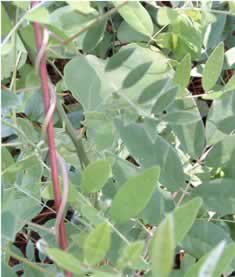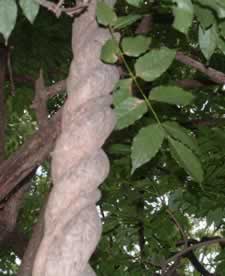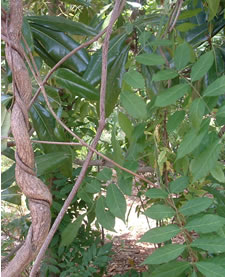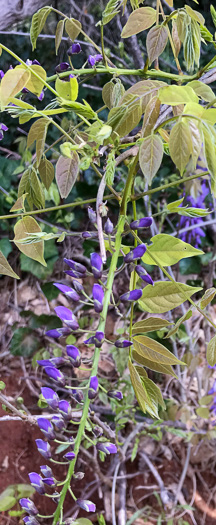As the vine twines
by Jan Haldeman*
Excerpted from Pause for Plants, 4 July 2007. Used by permission.
To see pictures or additional information about a particular plant, click its name.
Several 19th century naturalists, including Charles Darwin and his son Francis, published books and papers on the subject of plant growth movements such as twining. Some vines like English ivy and Trumpet Creeper grow stem rootlets that grasp and give support as the vine climbs.
Other vines like Hops and Wisteria wind themselves around a support without root helpers. These types of vines usually have a predictable direction of twining. Some twine from left to right or clockwise twining, others twine from right to left which is counterclockwise. Botanically this plant growth movement phenomenon is termed circumnutation. Plants are able to twine (circumnutate) because cells on one side of the stem that is not touching the support are stimulated to grow faster than cells on the other side of the stem touching the support.
Twining direction can be determined by looking at (or imagining) the vine twining around a branch or pole. Look at the pole or branch from the base (from the direction from which the vine is growing).
Native wisteria, Wisteria frutescens, and Chinese wisteria, Wisteria sinensis, twine from left to right — clockwise, and Japanese wisteria, Wisteria floribunda, twines from right to left — counterclockwise.
Some confusion may come from using terms clockwise and counterclockwise, because when the vines are viewed climbing up their supports, it appears that they "spiral" in the opposite manner. If you look at the face of a clock, with a second hand on twelve, and the second hand moves from your left to your right, it is moving clockwise. If the second hand moves from your right to left it would be moving counterclockwise, or "backwards."
Left to right twining (clockwise) is also termed "dextrorse," and right to left twining (counterclockwise) is termed "sinistrorse."
My search for twining information yielded many sources reporting wrongly about Wisteria. These sources ranged from reputable botanical and horticultural publications to confused gardener online discussions. If I had just started with Alan Weakley's Flora, the best source for information about plants of our region, I would have avoided this mistake!
And when all else fails, observe the plant!
Look at the vine laterally or "straight on" at eye level, to see if it ascends to the left, or to the right.
Native (Wisteria frutescens) and Chinese (Wisteria sinensis) species both ascend from left to right (clockwise), and Japanese (Wisteria floribunda) from right to left (counterclockwise).

Native Wisteria, W. frutescens,
young stem ascending from left to right,
clockwise

Chinese wisteria, W. sinensis,
large and smaller vine stems twining around each other, ascending from left to right,
clockwise

Japanese wisteria, W. floribunda,
smaller stem twining around a larger one ascending from right to left,
counterclockwise
Predictable twining direction is a useful feature to help with identification of wisterias and other vines. In winter without blossoms or leaves, the fruit and/or twining direction could distinguish a species.
There are also some plants with indefinite twining, such as Climbing Nightshade, Solanum dulcamara, which is considered a "noxious" weed with a wide distribution that includes Georgia, Florida and North Carolina, but which has apparently not as yet been reported from South Carolina.
* Dr. Haldeman is Professor Emeritus of Biology, Erskine College, and former Chair of the South Carolina Native Plant Society's Exotic Species Committee.

